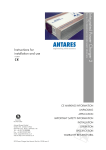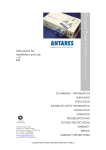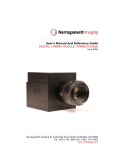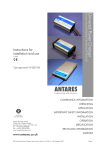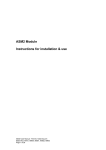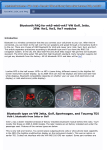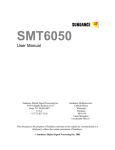Download pdf - Antares (Europe) Ltd.
Transcript
CE MARKING - INFORMATION UNPACKING MODE OF OPERATION PRODUCT SPECIFICATION INSTALLATION AND USE APPLICATION NOTES AND TIPS FM 37786 ISO 9001:2000 Antares (Europe) Limited Chiltern Hill . Chalfont St Peter Gerrards Cross . Bucks . SL9 9UQ . UK Tel: +44 (0) 1753 890888 Fax: +44 (0) 1753 891260email:[email protected] web site: http://www.antares.co.uk PRODUCT LISTING Instructions for Installation and use Automatic Split Charge System PRODUCT LISTING © 2004 TYPE APPROVAL - INFORMATION This manual is applicable to the following products: 90311 ASC - 12V/140A (Std Split charge) This family of products is type approved by the UK Vehicle Certification Agency. 90313 ASC - 24V/140A (Std Split charge) Type approval: e11022161 90314 ASC - 12V/200A (Std Split charge) 90315 ASC - 24V/200A (Std Split charge) Non approved conditions of use 90323 ASC – 12V/140A (Remote Sense) 90324 ASC – 24V/140A (Remote sense) 70096 ASC – 12V/140A (Dual Sense) 70097 ASC – 24V/140A (Dual Sense) 70284 ASC – 12V/160A (Dual Sense) 70196 ASC – 12V/60A (Batt sense disabled) 70085 ASC – 24V/30A (Batt sense disabled) 70182 ASC – 24V/140A (Trailer sense) This unit may be suitable for use in non-vehicular applications, but it can only be supplied as a component in this respect. If the unit is used in this way, as a component part to build a battery charging or similar apparatus, then this unit is supplied solely on the condition that it is the responsibility of the manufacturer of the apparatus to ensure that the apparatus complies with the requirements of the relevant legislation, and apply the CE marking should it be required. In this case, this user manual does not apply, and reference should be made to Antares (Europe) Limited for any information required for compliance with the legislation. UNPACKING Pack contents: 1 Antares Automatic Split Charge System 2 Instructions for installation and use. 3 Insulating boots for studs Page 1 Automatic Split Charge User Manual, Part No. 13150 Issue 5 MODE OF OPERATION Standard Version The MAIN battery terminal is monitored by a voltage sensing circuit which controls a switch linking the MAIN and AUX studs. When charging voltage is detected at the MAIN battery terminal the switch closes. The switch remains closed until the battery voltage falls to a level which indicates that the MAIN battery is being discharged. 90311 90313 70047 ASC 12V/140A (STD) ASC 24V/140A (STD) ASC 12V/160A (STD) Dual Sense Version This version should be is used where there is also likely to be a charging source on the auxiliary battery such as a battery charger or second alternator. Charging voltage on either battery will be detected and will cause the unit to link both batteries. It is installed in exactly the same way as the standard unit. Warning: Cranking the engine whilst a charging source is present on the auxiliary, may cause high currents to flow through the unit, which may cause damage. 70096 70097 70284 90314 90315 ASC 12V/140A (DUAL SENSE) ASC 24V/140A (DUAL SENSE) ASC 12V/160A (DUAL SENSE) ASC 12V/200A (DUAL SENSE) ASC 24V/200A (DUAL SENSE) Remote Sense Version This version should be specified where the split charge cannot be sited close to the primary battery. It is installed in exactly the same way as the standard unit. The additional red sense wire should be connected directly to the remote primary battery positive terminal. Note that connecting this to the main input stud reverts the unit to the standard auto split charge. 90323 90324 ASC 12V/140A (REMOTE SENSE) ASC 24V/140A (REMOTE SENSE) Battery Sense Disabled Version This version should be used where the auxiliary battery is commonly fully discharged in operation. It is installed in exactly the same way as the standard unit. Note that the battery sense is a safety feature. It protects the auxiliary system by preventing closure into a short circuit on the auxiliary or into a damaged or dead battery. Please note that regular full discharge of a lead acid battery is detrimental to its life. We would strongly recommend that some form of low voltage protection be applied to the auxiliary battery. 70196 70085 ASC 12V/60A (BATT SENSE DIS) ASC 24V/30A (BATT SENSE DIS) Trailer sense version This version should be used where the ASC is to be fitted to a trailer. The unit has voltage thresholds set to allow for distribution losses. 70182 ASC 24V/140A (TRAILER SENSE) INSTRUCTIONS FOR INSTALLATION AND USE Application The Automatic Split Charge unit protects the main starting battery from discharge by auxiliary loads on vehicles embodying dual battery systems. Where three batteries are required two ASC units may be "cascaded" to prioritised first the main battery then the auxiliary battery 1 and then auxiliary battery 2. The units are connected between the main battery and auxiliary 1 and between auxiliary 1 to auxiliary 2. Alternatively two ASC units can be used in parallel, connected between the auxiliary 1 to main battery and auxiliary 2 to main battery. Here the main battery will be protected from discharge by the auxiliary loads, however both auxiliary batteries will receive charge equally. The unit is suitable for under-bonnet mounting, but must be protected from road spray and engine fluids, particularly screenwash. IMPORTANT SAFETY INFORMATION Please read and observe the installation instructions, particularly with regard to cable sizing. Operation This unit is fully automatic in operation; no user intervention is required. Typical Installation Connections and indicators The Automatic Split Charge system is equipped with two 8mm or 10mm power studs, plus a low current ground wire, coloured blue. The remote sense version also has a red wire. In a normal installation the ‘MAIN’ stud should be routed to the vehicle engine start battery positive terminal. This is the battery fed directly from the main vehicle alternator. The ‘AUX’ stud connects to the second battery positive terminal. The cables used should be sized to carry the maximum current available from the main or second alternator, whichever is greater. The blue wire should be connected to the main battery negative terminal or to the vehicle chassis (provided the battery is also connected to chassis). The red remote sense wire (when used) should connect to the main battery positive terminal. Insulating boots are Page 2 Automatic Split Charge User Manual, Part No. 13150 Issue 5 provided, and should be used to cover the stud terminals on the unit. The green lamp illuminates when both batteries are linked together by the split charge unit. APPLICATION NOTES AND TIPS • Except for the 200 amp models, the ASC will not close if it does not sense a battery on the auxiliary stud unless battery sense is disabled. The battery voltage needs to be 3V or above (except battery sense disabled versions). • When connecting battery chargers, connect to the main stud if you require charging of both batteries. You do not need multioutput battery chargers. The system will automatically prioritise the battery connected to the main stud. For 200 amp models, the charger may be connected to either stud; whichever is required to be prioritised. • To optimise the charging of the auxiliary battery, locate the ASC as close to the main battery as feasible using large cables to minimise volt-drop. • You will need the “dual sense” version if you intend to provide charging to the auxiliary system directly via a second alternator or a battery charger and want these sources to charge the main battery. (Note: All 200 amp models are dual sensed as standard). Stud assembly sequence: Do not remove inner securing nut Maximum torque 8 N-m Cable ring terminal Testing & Commissioning After completion of the installation you should check the following: 1. Power stud nuts are tight, recommend 8Nm max 2. Remote sense wire (if used) is connected correctly 3. Blue ground wire is connected 4. With the engine off, the indicator should not be illuminated (Note: 200 amp models - the indicator remains on for approximately 20 seconds after activation). 5. Start the vehicle or apply a battery charging voltage. The indicator should show that the batteries are linked. This may take time as the main battery may be discharged and /or there may be a load on the primary system. 6. If linking does not occur then there may be insufficient voltage on the main stud check table above or the auxiliary battery is not present or discharged below 3V. 7. Stop the vehicle or remove charging source. The unit should unlink. If there is no load on the battery the “plate” voltage can sometimes remain high. If this occurs apply a load such as headlights and check that the system unlinks. (Note: 200 amp models - the system remains linked for approximately 20 seconds after activation). Cyclic switching of the unit will occur if the auxiliary battery is discharged and a load is placed on the auxiliary system that exceeds the capability of the charging source (alternator/battery charger). This is caused by the unit detecting that the additional current is being drawn from the start battery and will disconnect the auxiliary system and loads. The main battery voltage will recover and allow the auto split charge to attempt to reconnect thereby repeating the cycle. This condition will not cause short term damage to the unit and is the unit working correctly to protect the main battery from discharge. However if this situation persists we would recommend that the power balance on the vehicle is reviewed. Please call Antares application engineering for assistance. WARRANTY The split charge comes with a full parts and labour 'return to base warranty, held for two years from the date of invoice. Please telephone Antares first to confirm that the problem lies with the unit and obtain a Returns Authorisation Reference. Units will normally be repaired or replaced, and shipped within 5 working days of receipt, subject to availability of parts. Full details of the warranty provisions are contained in our 'Terms and Conditions of Sale'. Page 3 Automatic Split Charge User Manual, Part No. 13150 Issue 5 PRODUCT SPECIFICATION MAIN stud transfer voltages: Part number 90311 90313 90314 90315 70047 70085 70096 70097 70182 70196 70284 Closing voltage, minimum 12.90 25.60 13.09 26.16 12.90 25.60 12.90 25.60 25.80 12.90 12.90 Closing voltage, maximum 13.50 26.80 13.63 27.23 13.50 26.80 13.50 26.80 26.90 13.50 13.50 Opening voltage, maximum 13.10 25.80 12.91 25.79 13.10 25.80 13.10 25.80 24.00 13.10 13.10 Opening voltage, minimum 12.50 24.70 12.40 24.78 12.50 24.70 12.50 24.50 23.00 12.50 12.50 13.63 27.23 12.91 25.79 12.40 24.78 AUX stud transfer voltages: 200 amp models: 90314 90315 13.09 26.16 AUX stud transfer voltages: Other models, MAIN stud at nominal voltage, 12 or 24V 70096 70097 70284 13.2 25.5 13.2 13.8 26.6 13.8 Note: for these models, AUX stud thresholds depend on MAIN stud voltage Overvoltage disconnect: 70047 70284 16.5 volts max 16.5 volts max Current ratings: Continuous Current -current de-rated to Switching current, make Switching current, break 140 100 300 70* 160 120 300 70* 200 160 300 70* Power draw, closed Power draw, open Power draw, open 5 24 0 10 24 0 10 90 90 Amps @ 20°C Amps @ 85°C Amps 1s max Amps max *derated on battery sense disabled to 60A@12V and 30A @24V Watts (typical) milli watts main stud milli watts aux stud Environmental Ratings: Protection IP66 epoxy coated electronics, aluminium enclosure, detergents must be avoided Temperature range -10°C to + 85°C, with current derating as above (Survival –25°C to + 90°C) 0-100% with condensation and occasional water spray, but contact by detergents must be avoided to prevent corrosion Humidity Enclosure Dimensions 140 amp models: footprint 67mm x 140mm, including flanges. 160 & 200 amp models: footprint 134mm x 140mm, including flanges. Height 34mm (+ 20mm for studs). 200 amp models: 54mm (+30mm for studs) Fixings on 127mm centres, 4mm clearance holes. Weight Less than 1kg Indicators Green LED illuminates when contacts are closed MAIN BATTERY Connections 8mm stud, or 10mm stud on 200 amp models AUX BATTERY 8mm stud, or 10mm stud on 200 amp models GROUND 1m length blue wire, 1mm2 REMOTE 1m length red wire, 1mm2 Page 4 Automatic Split Charge User Manual, Part No. 13150 Issue 5 APPLICATIONS DIAGRAM CHARGE INDICATOR LAMP ON = SPLIT CHARGE RELAY CLOSED AUTOMATIC SPLIT CHARGE "MAIN" STUD "AUX" STUD BLUE WIRE CHARGER INPUT (IF REQUIRED) IGNITION, & OTHER PRIMARY CIRCUITS Page 5 Automatic Split Charge User Manual, Part No. 13150 Issue 5 (AUX) (AUX) ENG. START BATTERY 2nd ALTERNATOR (IF FITTED) BATTERY (STARTER) ALT. BATTERY STARTER SOLENOID (STARTER) MAIN ALTERNATOR BATTERY AUXILIARY CIRCUITS ALT. Antares (Europe) Limited Chiltern Hill Chalfont St Peter Gerrards Cross Buckinghamshire SL9 9UQ UK www.antares.co.uk Tel: +44 (0) 1753 890888 Fax: +44 (0) 1753 891260 ❑ PRODUCT RETURNS FORM M ❑ ADVANCE REPLACEMENT RETURNS FORM Date (TICK BOX ABOVE TO INDICATE TYPE OF RETURN) PLEASE USE THIS FORM TO ACCOMPANY RETURNS TO ANTARES (EUROPE) LIMITED. This will enable us to expedite your repair/return more efficiently. If you have your own return form, please attach it to this form. After receipt of your return we will either repair or replace the unit if within our warranty. If outside our warranty, we will provide a written quotation for repair/replacement. Please note that in the case of a ‘no fault found’ or the repair does not proceed, then a charge of £25 ex VAT and return carriage (if required) is payable. Goods arriving without suitable paperwork will take longer to process. Contact Company Name Delivery Address (for return) Part Number Serial Number Product Description Vehicle Type Registration/your reference Contact Fax Contact Tel Reason for return ( ( ( ( ( ( ( ) ) ) ) ) ) ) Advance replacement returned for credit against invoice ..… RA ……… Incorrect supply Please repair under warranty (Invoice date ……/……/……) Please quote for repair Please repair – purchase order attached ( ) Not required (note there may be a restocking charge) Unit for reconditioning (advance replacement RA# ………………) Description of observed fault and additional relevant information continued on separate page ( ) Form 040 Issue 8 26.07.04






